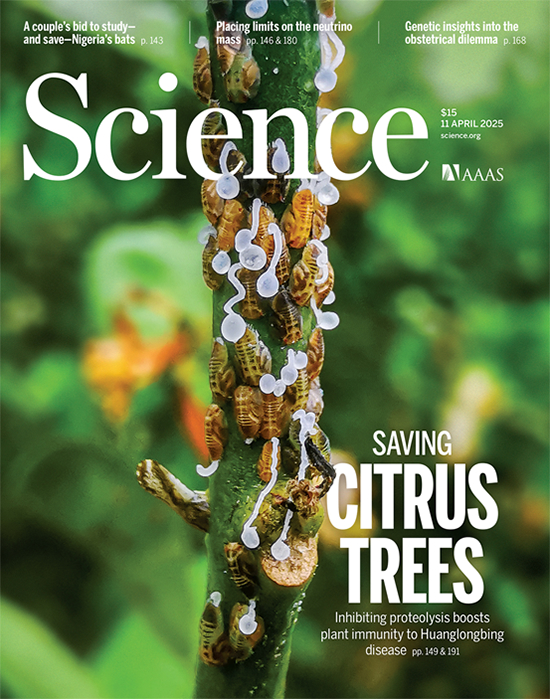Supported by National Science Foundation of China (No. 32125032), a collaborative study led by Prof. Ye Jian’s team at the Institute of Microbiology of the Chinese Academy of Sciences (IMCAS) and Prof. Wang Xuefeng’s group at Southwest University, has made progress in natural defense mechanism against citrus huanglongbing (HLB), a deadly plant illness that has devastated citrus farms worldwide. The breakthrough was published with title “Targeted MYC2 stabilization confers citrus Huanglongbing resistance” in the journal Science as a cover story on April 11, 2025. (Fig. 1)
HLB, also called citrus greening disease, is one of the most destructive plant diseases in modern agriculture, causing billions of dollars in losses annually. The disease, primarily triggered by the bacterium Candidatus Liberibacter asiaticus (CLas), is spread by the Asian citrus psyllid (Diaphorina citri). With no known cure, HLB has devastated millions of acres of citrus crops across 50 countries in Asia, Africa, the Americas, and Europe, making it a “100-year disease” due to its profound impact and the difficulty of eradication. All commercial citrus varieties are susceptible, and once infected, trees typically perish within a few years.
To address this issue, the researchers identified a key resistance pathway involving the transcription factor MYC2 and its interacting E3 ligase, PUB21. By examining citrus species and their distant relatives in the Rutaceae family, they discovered PUB21 paralogs in Bergera koenigii (curry leaf plant) and Zanthoxylum bungeanum (Sichuan pepper plant). These paralogs encode a dominant-negative form of PUB21 (PUB21DN), featuring a crucial mutation at residue 39 that suppresses PUB21 activity. This suppression stabilizes the MYC2 protein and significantly enhances defense pathways and antibacterial metabolites production, conferring immunity to HLB. Transgenic citrus plants engineered to overexpress PUB21DN demonstrated increased resistance to the disease.
Building on these natural resistance mechanisms, the researchers used AI-driven screening technology to stabilize MYC2 by inhibiting PUB21 activity. Through this approach, they identified a group of anti-proteolysis peptides (APPs), including APP3-14, which showed promising results in both greenhouse and field trials. APP3-14 not only effectively controlled the HLB-causing pathogen CLas but also disrupted disease transmission, achieving a up to 80% control efficiency in a single season. (Fig. 2)
This breakthrough offers a dual benefit: the development of druggable peptides for eco-friendly bio-pesticides and a novel strategy to combat uncultivable pathogens through targeted protein stabilization. Beyond HLB, this strategy could help address other plant diseases caused by difficult-to-culture pathogens, such as maize rust fungus and Xylella fastidiosa, which leads to Olive Quick Decline Syndrome (OQDS). By targeting pathogen effectors and stabilizing host immune proteins, this study paves the way for innovative disease resistance solutions in various crops, offering new hope for global agricultural sustainability.

Figure 1: Science cover featuring the research

Figure 2: Decode natural resistance against citrus greening disease and Develop AI-designed disease treatment

Add: 83 Shuangqing Rd., Haidian District, Beijing, China
Postcode: 100085
Tel: 86-10-62327001
Fax: 86-10-62327004
E-mail: bic@hiebridge.org
京ICP备05002826号 文保网安备1101080035号 Copyright 2017 NSFC, All Right Reserved